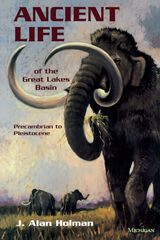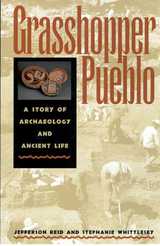2 books about Ancient Life

Ancient Life of the Great Lakes Basin
Precambrian to Pleistocene
J. Alan Holman
University of Michigan Press, 1995
Today, Michigan is home to many different animals and plants. Yet nearly 12,000 years ago it was home to very different kinds of animals and flora. Huge mastodons and mammoths roamed through southern Michigan. Whales, walruses, and giant rodents swam in the lakes, and shaggy musk oxen grazed in the woodlands. Now, 2000 years later, all but their fossils are gone.
Ancient Life of the Great Lakes Basin provides a one-of-a- kind look at ancient life in the Great Lakes. Written for the layperson and for the professional with biological or geological interest in the Great Lakes region, the book describes most of the common fossils found in this region. Detailed illustrations help identify many of the fossilized organisms that can be found today. Among the most interesting illustrations presented in the book are Gijsbert van Frankenhuyzen's conceptions of what the fossilized creatures may have looked like when they were alive. In addition, color illustrations by van Frankenhuyzen depict spectacular scenes of ancient life in the Great Lakes area.
The book begins with a brief review of biological and geological principles and then offers a framework for the study of the fossil record. Methods of collection, preservation and maintenance of fossils are also presented. Throughout the book, common fossils found today embedded in rocks and other solid matter are emphasized.
J. Alan Holman is Curator of Vertebrate Paleontology in the Michigan State University Museum, and Professor of Geological Sciences, Michigan State University.
[more]

Grasshopper Pueblo
A Story of Archaeology and Ancient Life
Jefferson Reid and Stephanie Whittlesey
University of Arizona Press, 1999
Located in the mountains of east-central Arizona, Grasshopper Pueblo is a prehistoric ruin that has been excavated and interpreted more thoroughly than most sites in the Southwest: more than 100 rooms have been unearthed here, and artifacts of remarkable quantity and quality have been discovered. Thanks to these findings, we know more about ancient life at Grasshopper than at most other pueblos. Now two archaeologists who have devoted more than two decades to investigations at Grasshopper reconstruct the life and times of this fourteenth-century Mogollon community.
Written for general readers—and for the White Mountain Apache, on whose land Grasshopper Pueblo is located and who have participated in the excavations there—the book conveys the simple joys and typical problems of an ancient way of life as inferred from its material remains. Reid and Whittlesey's account reveals much about the human capacity for living under what must strike modern readers as adverse conditions. They describe the environment with which the people had to cope; hunting, gathering, and farming methods; uses of tools, pottery, baskets, and textiles; types of rooms and households; and the functioning of social groups. They also reconstruct the sacred world of Grasshopper as interpreted through mortuary ritual and sacred objects and discuss the relationship of Grasshopper residents with neighbors and with those who preceded and followed them.
Grasshopper Pueblo not only thoroughly reconstructs this past life at a mountain village, it also offers readers an appreciation of life at the field school and an understanding of how excavations have proceeded there through the years. For anyone enchanted by mysteries of the past, it reveals significant features of human culture and spirit and the ultimate value of archaeology to contemporary society.
Written for general readers—and for the White Mountain Apache, on whose land Grasshopper Pueblo is located and who have participated in the excavations there—the book conveys the simple joys and typical problems of an ancient way of life as inferred from its material remains. Reid and Whittlesey's account reveals much about the human capacity for living under what must strike modern readers as adverse conditions. They describe the environment with which the people had to cope; hunting, gathering, and farming methods; uses of tools, pottery, baskets, and textiles; types of rooms and households; and the functioning of social groups. They also reconstruct the sacred world of Grasshopper as interpreted through mortuary ritual and sacred objects and discuss the relationship of Grasshopper residents with neighbors and with those who preceded and followed them.
Grasshopper Pueblo not only thoroughly reconstructs this past life at a mountain village, it also offers readers an appreciation of life at the field school and an understanding of how excavations have proceeded there through the years. For anyone enchanted by mysteries of the past, it reveals significant features of human culture and spirit and the ultimate value of archaeology to contemporary society.
[more]
READERS
Browse our collection.
PUBLISHERS
See BiblioVault's publisher services.
STUDENT SERVICES
Files for college accessibility offices.
UChicago Accessibility Resources
home | accessibility | search | about | contact us
BiblioVault ® 2001 - 2024
The University of Chicago Press









